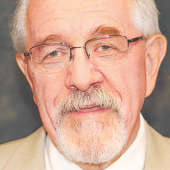- Christmas shopping is done, presents wrapped, strings attached? (12/14/16)
- Cecil is dead and human lives are threatened every day (8/12/15)
- As state flags go, Nebraska's ranks 50th (7/8/15)
- When everything looks like a nail (4/29/15)
- Who remembers to coal slurry pipeline debate? (3/11/15)
- More revelations in Department of Corrections mess (12/17/14)
- The Legislature becomes more Republican (11/19/14)
Opinion
Cattle deaths spell tragedy on the High Plains
Wednesday, October 30, 2013
There's never a good time for a blizzard in the High Plains ... but there are some really bad ones. The bookend blizzards in January 1949 were probably the most historic of the worst ones. An estimated 500,000 farm animals died in that storm as ranchers were contemplating spring calving on the cusp of economic recovery from World War II.
Many of those same areas were just hit again the first weekend of this October when a mix of rain, heavy snow and 70 mph winds came. As I discovered in the 1970s flying over the Sand Hills with a couple of state senators and the Nebraska National Guard, the wind usually blows out the back sides of the hills and keeps life-saving grass exposed. The area looks from the air like a rancher has left a boot heel imprint that stays open.
But when rain accompanies the snow, the white stuff goes on like frosting and the blowouts are coated as well. Cattle instinctively walk with their backs to the wind ... and sometimes they walk for long distances without the distraction of grass on which to nibble. In the storms of 1949 and this October, that walk was a death march.
My trip 40 years ago was with then-state Sen. Howard Lamb of Anselmo. He explained winter and the danger of blizzards in the sprawling 43rd District, which has always had more cows than people. Current Senator Al Davis, a Hyannis rancher, recently spoke of the impact of the October storm on the district that covers 17,000 square miles, bigger than several New England states combined.
Davis and others emphasize the overwhelming economic impact of cattle loss to a rancher. Ranchers were on the cusp of selling calves, which is what generates their annual income. The calves that died represent a full year's earning. The storm also killed cows pregnant with next year's calves, so next year's income is gone. And then there's the loss of future calving potential.
All this came at a time when the federal government was shut down and application for the livestock indemnity program -- a safety net for such disasters on ranches -- was also shut down. Ranchers had to pay for disposal of the dead carcasses to prevent the spread of disease. A spokeswoman for the Nebraska Cattlemen's Association said the losses were the worst in at least 50 years.
Three people died in a weather-related automobile accident in Dawes County in northwest Nebraska. The 1949 blizzard killed six. The state's worst-ever blizzard, the Schoolhouse Blizzard of 1888, killed 235 school children who were stranded in a number of country schools. Many died when heating oil ran out. Others died while trying to get to shelter elsewhere.
The reluctant hero of that blizzard was schoolteacher Minnie Freeman, who led 13 students from their school to her house about a mile away. A mural of that rescue is featured on the east wall between the north doors and the Rotunda at the State Capitol. It's a grim reminder of the perils of weather and winter in this expansive state.
Folks who exhibit the cussed independence it takes to live in these mostly square states out west also exhibit a tremendous spirit of self-reliance. They'll weather this economic crisis and the pending cold and moist weather to come. A fund has been established to help. The Cattlemen Relief Fund, PO Box 1125, Chadron, NE 69337 is currently accepting donations. Give if you can. It's a great idea.

